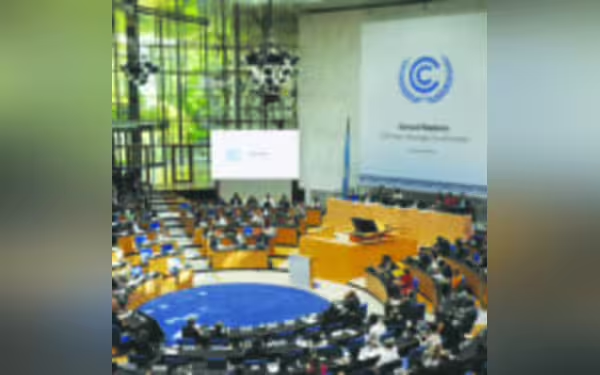Saturday, November 23, 2024 07:17 PM
Climate Finance Crisis in Developing Nations
- Developing countries face severe climate finance shortages.
- Adaptation funding is critically underfunded.
- Accountability in climate finance remains a significant issue.
 Image Credits: pakistantoday
Image Credits: pakistantodayDeveloping nations struggle with inadequate climate finance, facing urgent needs for adaptation and accountability.
Climate change is a pressing issue that affects everyone, but it hits developing countries the hardest. These nations often lack the resources to deal with extreme weather events like floods, droughts, and desertification. Climate finance is crucial in this context, as it involves providing financial support to help these countries cope with the impacts of climate change. However, the current climate finance system is not functioning as it should, and many developing nations are left struggling to survive.
To illustrate the problem, consider this analogy: Imagine your neighbors are polluting your garden with toxic waste, ruining your plants and contaminating your water. Instead of helping you clean it up, they offer to sell you expensive bottled water and special seeds that can grow in the damaged soil. In this scenario, you are not only paying to survive in an environment they ruined, but you are also enriching them by buying their products. This is similar to what is happening in the climate finance ecosystem today.
Currently, about half of the climate finance comes from multilateral institutions and governments, such as the Green Climate Fund, while the other half is sourced from private enterprises. Despite this funding, the amount directed towards developing countries is insufficient. According to the Climate Policy Institute, climate financing needs to increase sixfold to reach $8.5 trillion by 2030 to meet the Paris Agreement goal of limiting global warming to 1.5°C.
Historically, climate finance has focused on two main areas: mitigation and adaptation. Mitigation involves reducing greenhouse gas emissions, primarily through investments in sectors like transport and energy. While these investments are essential, developing countries also need significant funding for adaptation. As climate change leads to rising sea levels and more frequent natural disasters, these nations face a double crisis. They must rebuild infrastructure like schools and hospitals while also addressing poverty and providing basic necessities for their citizens.
Estimating the cost of adaptation is challenging. A UN report from 2023 estimated that developing countries need around $215 billion per year for adaptation, but some private banking institutions predict this figure could rise to nearly $2 trillion annually by 2026. Additionally, the quality of climate finance is a significant concern. Most funding comes in the form of loans rather than grants, trapping developing countries in a cycle of debt. High borrowing costs and a lack of financial infrastructure further complicate their ability to attract foreign investments.
Moreover, accountability in climate finance is often lacking. Wealthier nations sometimes inflate their climate investment reports, which can lead to greenwashing in the private sector. On a more positive note, blended finance—a combination of public and private funding—has been on the rise. A report from a Canada-based blended finance network revealed that climate blended finance deals doubled to $18.3 billion in 2023. However, adaptation funding remains severely underfunded, with only a fraction of blended finance transactions directed towards it.
The New Collective Quantified Goal on Climate Finance (NCQGF) offers a glimmer of hope. This initiative aims to improve the quality, quantity, and purpose of climate finance. Developing countries are now advocating for a more concrete funding target, with Pakistan suggesting a minimum of $2 trillion. While developed nations propose a broader range of funding sources, there is still uncertainty about which countries should contribute and how to classify them based on emissions.
The challenges surrounding climate finance are complex and multifaceted. Developing countries require not only more funding but also better quality support to adapt to the realities of climate change. As the world grapples with this urgent issue, it is essential to ensure that financial resources are allocated effectively and equitably, allowing all nations to thrive in a changing climate. Only through collective action and accountability can we hope to address the pressing needs of those most affected by climate change.













